The Market Cross
 The Market Cross stood in Market Square
The Market Cross stood in Market Square
It was erected by Martin Nangle, whose sister Catherine married Nicholas Herbert, and the coats of arms of these families can be seen on one side of the cross, along with the arms of the Dowdalls, another early Norman family, indicating intermarriage betwen these families.
It dates from c. 1585, and has 4 carved sides. It was uprooted during Penal times probably during the first half of the 17th century. In the past it was customary for coffins to be carried around the cross before burial.
A fragment survives, enough to place it as one of the tall pillar crosses
erected in Meath around this time. (left)
The Market Cross fragment was returned to Navan by the National Museum in 2011 and is now on permanent display in the Solstice Arts Centre.
*******
The photos of the Market Cross fragment shown here, were taken by one of our members Hilary Tullach, and are shown courtesy of the National Museum.
*******
The article below is by Rev.C.C Ellison,
published in Ríocht na Mídhe, 1963, Vol. II, No. 1
One of the stones from the ancient Market Cross Cross was found by W.F. Wakeman in 1849 and removed to the Royal Irish Academy. It is now in the National Museum.
Judging by the slender shape of this stone, the Cross seems to have been a tall pillar, carved or inscribed on each side, with perhaps a small ornemental cross at the top.
Wakeman relates how he found the stone built into a wall in "a miserable back lane, branching from Trimgate Street," and was allowed to remove it. Hearing of two similar stones, being used as support for casks in a public house in Trimgate Street, he used every endeavour to be allowed to make drawings of them and offered to pay for any trouble caused in removing the casks. But he was at first flatly, and at length insolently refused. (P.R.I.A. 1849.)
These two stones were probably the ones described by Dean Cogan as "preserved by a family in the town." One of them, he says; "has an inscription in Irish commemorative of the sufferings of Christ, and His opening Heaven to us. The other has a figure of St. Patrick, with mitre and crozier, on one side of which is 'S' (Saint) and on the other 'P' (Patrick); a second side has a shield and a figure of a bird, perhaps the arms of the Nangles. The Nangle crest was a falcon. (Burke, General Armory.)"
A third side has the 'Ecce Homo' crowned with thorns; and the fourth has a crowned figure of the Blessed Virgin, with the Infant Jesus in her arms." Cogan, Vol 1, 229-30.
Sir William Wilde in his classic work, The Beauties of the Boyne and Blackwater, says: " It is probable that a cross existed in this town in the market place, where all passing funerals now make a solemn circuit. A friend of ours possesses a portion of a small sculptured cross lately dug up in Navan. This may refer to the stone preserved at the east end of St. Mary's Church of Ireland Church, upon which can still be seen on one side a crowned figure bearing a sword in the right hand, and on the other a mitred bishop.
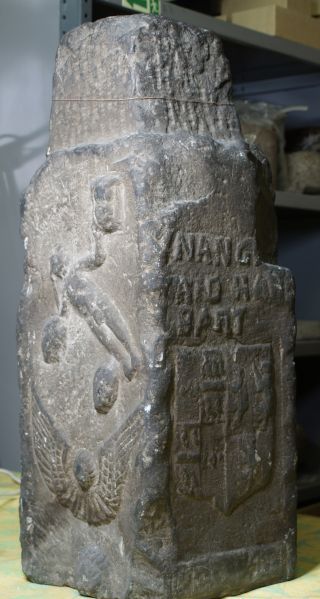 The stone rescued by Wakeman is 22 inches in height and 8 inches square. At the bottom is a small dowel hole about an inch square, while at the top the stone tapers so as to fit a socket in a stone or cross bar above. Lodge's Peerage of Ireland mentions an ancient inscription in stone, probably part of a gateway erected by Martin and Alisona (Nangle) in 1589.
The stone rescued by Wakeman is 22 inches in height and 8 inches square. At the bottom is a small dowel hole about an inch square, while at the top the stone tapers so as to fit a socket in a stone or cross bar above. Lodge's Peerage of Ireland mentions an ancient inscription in stone, probably part of a gateway erected by Martin and Alisona (Nangle) in 1589.
The Rev. Mervyn Archdall, who revised the work, adds in a footnote, "Market Cross of Navan, now in the churchyard of that town." Lodge, Vol. 111, 79.
The stone has on one side a shield (below left) the arms of the Nangles. (Az. Three fusils or lozenges conjoined in fees or.), quartered with those of Dowdall (Fees between five martlets - Martin's great grandfather, John, married Elinor, heiress of Sir Thomas Dowdall), and impaled with those of the Herberts, three lions rampant. Above it are the names Nangle and Harbart, and below almost some obliterated letters, which may be "obit 1585".
According to Sir William Beetham, Martin, eldest son of Patrick, Baron of Navan and his wife Janet, daughter of Martin Blake of Athboy, Martin Blake was a prosperous merchant (Riocht na Midhe, 1961, p.43) married Alison, daughter of Sir Francis Herbert of Coghlanstown in Co. Kildare. He died before his father in 1585 and his son Thomas succeeded to the Barony in 1595. P.R.I.A. 1849.
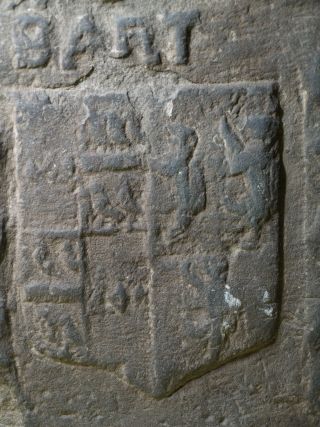 Lodge terms the said Martin Nangle the third son of the third Viscount Gormanston, thus giving him the family name of Preston, and continues "their (Martin's and Alison's) issue was Hugh, who married a daughter of Joclyn Nangle, Baron of Navan, and by this marriage he became possessed of Ardsallagh and also the Corporation of Navan."
Lodge terms the said Martin Nangle the third son of the third Viscount Gormanston, thus giving him the family name of Preston, and continues "their (Martin's and Alison's) issue was Hugh, who married a daughter of Joclyn Nangle, Baron of Navan, and by this marriage he became possessed of Ardsallagh and also the Corporation of Navan."
This statement, since copied by several historians, seems to be an error. The obituary notice of the 3rd Viscount Gormanston gives his issue as one son, Christopher, and five daughters. Journal Royal Society Antiquaries Ireland 1932. G.D. Burtchaell, a noted authority, comments "There is no such person as Martin Preston. The husband of Alisona Herbert was Martin Nangle.
Lodge or Archdall incorrectly copied the entry. "Martin was the grandson of Sir Thomas Nangle whose wife was the eldest daughter of Jenico, third Viscount Gormanston. After the death of Sir Thomas, she married Richard Nugent, Baron Delvin. The only Jocelyn Nangle, Baron of Navan, who appears in the family pedigree is the original recipient of the Barony in the 12th century. Ulster's Office, Vol.17, p. 381. Beetham states that Martin Nangle's sister, Catherine, married Nicholas, eldest son of Sir Francis Herbert. In the Ulster's Office pedigree Catherine is entered as the first wife of Nicholas Herbert of Ballycotton.
Another source (Pedigrees of many Irish Families, Trinity College Dublin Library Ms. F.418) gives Alison Herbert in the Nangle pedigree as daughter of Sir Jasper Herbert of Durrow, and in the Herbert pedigree as the daughter of Nicholas of Ballycotton and his first wife, Agnes Plunkett. Catherine Nangle is entered here as his second wife. Sir Jasper was the youngest son of Nicholas Herbert, who inherited his Durrow estate and built Ballycowan castle there in 1626. Probably there was more than one Alison Herbert, hence the confusion in the perdigree. Francis Herbert, a Dublin merchant and alderman, was sent by the citizens to warn the King of Silken Thomas' rebellion, and as a reward was dubbed a knight and "infeoffed with part of Christopher Eustace of Balicutlan his lands" (Holinshed). In addition to Ballycotland or Coghlanstown, Co. Kildare, he also had an estate at Portlester, Co. Meath, and married Janet Golding of Piersetownlandy, Co. Meath. His son and heir, Nicholas, got a lease from the Crown of the lands of Edenderry, and the dissolved religious houses of Monasteroris and Darrow (Journal Kildare Archaeological Society, Volumes V11 and V111).
Ardsallagh, together with vast estates in Meath and Laois, was granted to John Preston under the act of Settlement in 1666. (Burke. Dormant and Extinct peerages.) He was son of Hugh Preston of Bolton in Lancshire,and served as Mayor of Dublin in 1653-54 and M.P. for Navan in 1661. He founded the Preston Schools in Navan and Ballyroan in 1686.
The first of his three wives was Mary Morris of Bolton. Their grandson, John of Ardsallagh, had a son Phineas, who died without issue, and a daughter Mary. This heiress married Peter Ludlow and their son Peter was created Baron Ludlow of Ardsallagh in 1755, and Viscount Preston of Ardsallagh and Earl Ludlow in 1760. Peter, Earl Ludlow,married Lady Frances Saunderson, daughter of the third Earl of Scarborough, but their children all died unmarried and the titles became extinct. The second son, George James, third Earl Ludlow, served in the British Army during the War of American Independence and the French wars, and rose to the rank of General. "Having no near relatives, he devised his estates to the well known statesman Lord John Russell, from admiration of his political character."
( The Complete Peerage, edited Doubleday).
They are interred beneath Navan Church, as is recorded by a marble tablet erected on the south wall of the nave by the Duke of Bedford in 1858. About the same time the Duke, to whom Ardsallagh had descended, demolished the ancient castle of the Nangles and built a Tudor style mansion on the site. (Butler, Trim Castle, 4th edition 277)
Mrs Delany, about 1732, commented on the fine gardens, and remarked that the house, although old, was a good one (Letters, 1, 374 and 11, 498). A few years later, Isaac Butler noted that the house was lofty and well designed, with " a delightful garden and curious subterraneous grottoes" (A Journey to Lough Derg). Sixty years later, throu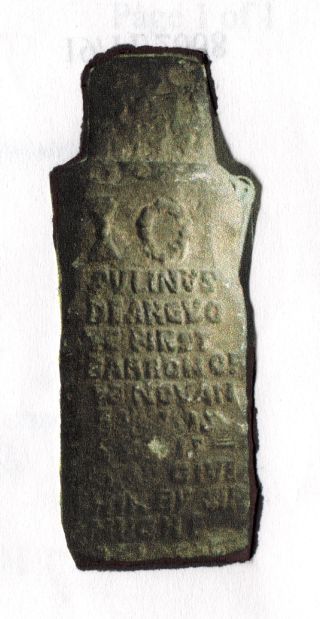 gh the non residence of its owners the building had fallen into decay and presented a dismal prospect with the timber all gone and a "solemn silence" reigning over it ( Thomas Bell, Descriptive Sketches, 1809).
gh the non residence of its owners the building had fallen into decay and presented a dismal prospect with the timber all gone and a "solemn silence" reigning over it ( Thomas Bell, Descriptive Sketches, 1809).
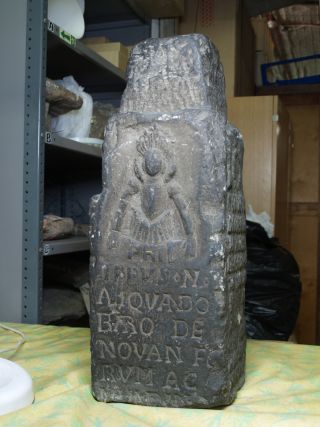
The second side of the stone (above left) has the inscription in relief, "10 sulinus de Angulo the first baron of the Novan (for his servis was given) him by Sir Hughe de Lacie... The letters are partly obliterated, but this seems to be the probable reading.
Sir Hugh's ancestors, who are said to have been descended from Charlemange, came from Lassy in Normandy with the Conqueror, and carved out huge estates on the Welsh border. After the Anglo Norman invasion King Henry 11, for the service of 50 knights, granted him the whole Kingdom of Meath, and large tracts of land round Dublin and in the counties of Carlow, Offaly and Longford. de Lacy Bellingari. "The Roll of the House of Lacy."
He in turn parcelled out estates to his knights. To Gilbert de Angule he gave Morgallion, and to his son Jocyln, Navan and Ardbraccan. The Nangles were dispossessed by Cromwell but recovered some of their lands at the Restoration, finally forfeiting them after the Battle of the Boyne. The name de Angulo is said to come from the place still called Angle in Pembrokeshire,where the family had settled after the Conquest. It later became changed to Nangle in Leinster, Nagle in Munster, and Costelloe in Connaught. Various other renderings are also to be found such as de la Corner and Nangyll.
The third side (pictured above right) has at the top a three quarter length figure, which looks like that of a lady in Elizabethan costume. Perhaps to represent the patron of the market. Under it is the name Philippus in relief, followed by the incised letter N, with a lozenge of the family arms on each side, and the words "aliquando baro de Novan forum ac nundina."
(i.e."Philip Nangle, formerly Baron of Navan, a market place and a market or fair day.")
Nundina was the Roman Godess, who presided over the naming of infants, boys on the ninth and girls on the eight day after birth. Hence nundina or the ninth day came to denote the periodic market day, upon which the people came into the city for business and to attend to public and religious affairs. The wording probably continued with the details of the granting of this privilege, which could only be given by the king or feudal lord and was a source of considerable revenue.
Philip Nangle's father and grandfather had been deprived of their lands for rebellion, but obtained a pardon from King John in 1207, the former being again in possession of land in Kilbixy and elsewhere by the year 1210.
In 1215 Walter de Lacy, son of Sir Hugh, having been restored to the Earldom of Meath after the signing of Magna Carta, made a new grant of Meath lands to Philip Nangle. Philip Nangle also appears to have been granted lands in County Cavan and in Connaught by Walter de lacy between November 1220 and July 1221. A claim for rents, based on this Grant, by Thomas Nangle in 1551 was upheld in part by the Council
(Journal Royal Society, Antiquaries Ireland, 1903, p. 183).
The inscription shows that the right to hold fairs in Navan was probably included in this grant.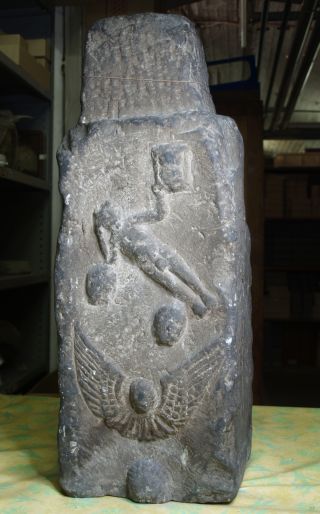 The fourth side seems to be a symbolic representation of mortality and immorality.
The fourth side seems to be a symbolic representation of mortality and immorality.
Above is a naked figure with the head supported by the right arm.
The elbow rests on a globe like object, perhaps a skull.
The left arm is extended and the hand is holding what appears to be an hour glass.
Underneath the figure are two other skulls (?)
and between them a head with formalised
wings on each side of it.
The winged head may symbolise the soul of man
leaving behind the earthly body.
______________________________________________________________________________________________
Sir William Bethan read the following account of a squared stone in the Museum of the Royal Irish Academy, sent there from Navan, in the County of Meath, by W. F. Wakeman, Esq.
“This stone appears to have been apportion of the shaft of a market cross, and served to commemorate certain members of the ancient family of Nangle, of De Angulo, Barons of the Navan, in the Palatinate of Meath.
It was erected by Martin Nangle, Esq., eldest son of Patrick Nangle, Baron of Navan, by his wife, Genet, daughter of Martin Blake, of Athboy, in the county, who died before his father in 1585. He was married to Alson, daughter of Sir Francis Herbert, of Ballycotland, in the county of Kildare, ancestor to the Herberts of Durrow, by whom he had Sir Thomas Nangle, Baron of the Navan, who succeeded his grandfather, Patrick, on his death in 1595. Nicholas Herbert, eldest son of Sir Francis, married Catherine, sister of said Martin Nangle.
I have made a rough sketch of what remains of the inscriptions on each side of the stone, to which I now refer.
No. 1 contains a shield of the arms of Martin Nangle, impaled with those of his wife, viz.: first and fourth azure, three lozenges in fess or, for Nangle; second and third argent a fess between five marlets, three in chief, and two in base gules, for Dowdall, impaled with per pale, azure and gules, three lions rampant, two and one argent, within a border gobony, argent and sable, for Herbert*. Over the shield are the names NANGLE AND HARBART.
No. II is the following description:-
IO
SVLINVS
DE ANGVLO
THE FIRST
BARRON OF
THE NOVAN.
IS
IS=
GIVE
HIM BY SIR
HVGHE
DE L CIE
No. III is the representation of a lady in the costume of the time of Queen Elizabeth’s days, under which is:
PHIL
IPPVS-N-
ALIQVANDO
BARO DE
NOVAN FO
RVM AC
NVNDIN
No IV On this side is a head with wings, three globes, or roundlets, two above and one below: over all a naked human figure, with the right hand up to the head, the left extended, holding an hour-glass. What these emblems are intended to signify I leave to the imagination and ingenuity of others.
Of No. I, I have already given an explanation.
No. II. This portion of the inscription gives a hint at the history of the family of Nangle.
IOSVLINUS DE ANGVLO THE FIRST BARRON OF THE NO-
VAN….. IS ….. IS .. GIVEN HIM BY SIR HVUG DE LACIE….
Gilbert de Angelo and his son, Joceline, came over to Ireland with the Earl Strongbow, who made Gilbert a grant of Magheragalen. His name appears as a witness to the grant of Howth to Sir Almeric de St. Laurence. He had two other sons besides Joceline, Hostilio de Angulo, who obtained a grant of lands in Connaught, afterward and now called after him, the barony of Costello, in the county of Mayo. His descendants were called Mac Histilio, corrupted into Costello, and his descendants and representatives are still possessed of a good estate in that barony. Another son settles in the county of Cork, having obtained a grant of lands in the barony of Fermoy, called Moneaminy. Silvanus Spenser, son of Edmond, the poet, married Ellen, eldest daughter of David Nangle, of Nagle, of Moneaminy, who died in 1637. Sir Richard Nangle, Attorney-General to King James II, was of this family, as is Sir Richard Nagle, of Jamestown in the county of Westmeath.
Joceline de Angulo, above mentioned, had a grant of the barony of Navan from Sir Hugh de Lacy, and thus, as stated in the inscription, became the first Baron of the Navan, and one of the magnates of the palatine honour of Meath.
Gilbert de Angulo, his son, second Baron, rebelled against King John, but, having submitted, had a pardon under the great seal, now on record on the Close Roll of the year 1207 in the Tower of London.
William de Angelo, son of Gilbert, was included in his father’s pardon, and paid 300 marks for a writ of a restitution of his lands, as appears in an entry on the Close Roll in the Tower of London for the year 1210.
Philip de Angulo, son of William, had livery of his lands in 1215. Walter de Lacy, then lord of Meath, granted and confirmed to him his lands, etc., in Meath, to which grant Geoffrey de Montemarisco (or De Marisco), Lord Justiciary of Ireland, was a witness. This Philip is the person alluded to in the inscription ‘aliquando Baro de Novan’, there having been no other Philip Baron of the Navan.
John Nangle, Baron of the Navan, who died in 1517, married Elinor, daughter and heir of Sir Thomas Dowdall, Knight, and this marriage is noted by the quartering of the arms of Dowdall on the stone No. I.
Patrick Nangle, Baron of the Navan, the grandson of Martin, became a Protestant, and married Mary, daughter of Sir Richard Bolton of Brazil, Knight, Lord Chancellor of Ireland, and had an only daughter, wife of Dudley Loftus, Esq., LL. D., Judge of the Prerogative Court of Armagh. He was succeeded in his barony by his brother, George Nangle, who died 1676, leaving a son, John Nangle, Baron of the Navan, living, 1685, leaving two sons, Thomas and Jasper, and four daughters.
There were many junior branches of this ancient family, of which the representatives still exist. The Nangles matched with the first and most boble families in Ireland.
It is to be regretted that the remainder of the stone has been lost. It may hereafter turn up.”
*The colours or border are not represented on the stone.
Source: On an Inscribed Stone Found at Navan, by William Betham, Proceedings of the Royal Irish Academy, (1836-1869), Vol. 4 (1847-1850), pp. 407-411
________________________________________________________________________________
85 Lower Camden Street, Dublin
December 3, 1849
Sir, - Had I been aware of your intention to notice the stone which formed the subject of your interesting paper read before the Academy on Friday evening lase, it would have given me great pleasure to have afforded you information relative to its history, and the circumstances which induced me to have it forwarded from Navan to Dubin. The stone, which appears to have formed a portion of the market cross of Navan, had been removed from its original place, wherever that was, and was used as a building stone in a comparatively modern wall connected with a miserable back lane, branching from the street called Trim Gate, Navan. Upon removing the stone from its position in the wall, for the purpose of drawing it, I found that it had formed a portion of the shaft of an old cross, and as the inscriptions upon its sides contained names of considerable historical interest, I begged the fragment from the owner of the wall in which it had been, and caused it to be removed to the rooms which I then occupied in Navan. I subsequently learned that two similar stones, which had evidently formed portions of the same cross were known to exist. They are used as supports for casks in a public house, in Trim Gate, Navan, and are sculptured and inscribed. I used every endeavour to be allowed to make drawings of them, and even offered to pay for any trouble caused in removing the casks, but was at first flatly, and at length insolently refused. Under these circumstances, and believing that, were I to leave the stone which I had already secured in Navan, it would be lost or broken up, or perhaps thrown into the Blackwater, as at least one monument of “the Novan” has been,. I caused it to be removed to the Academy, as the best place for its preservation which I could think of.
I remain etc., etc.,
W. F. Wakeman.
To Sir William Betham, Knight
Source: On an Isscribed Stone Found at Navan (Continued), William Betham and W. F. Wakeman, Proceedings of the Royal Irish Academy, (1836-1869), Vol. 4 (1847-1850) pp. 421-422